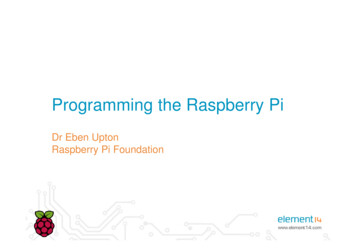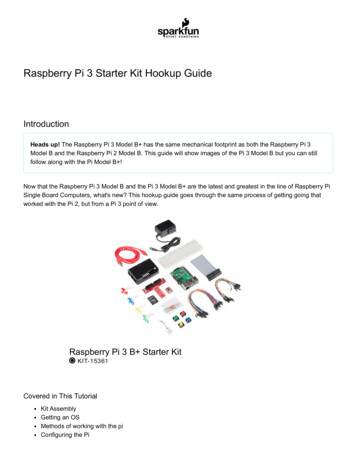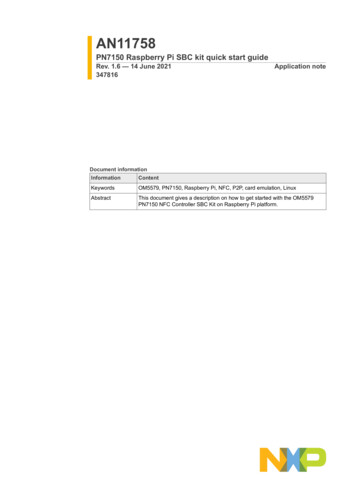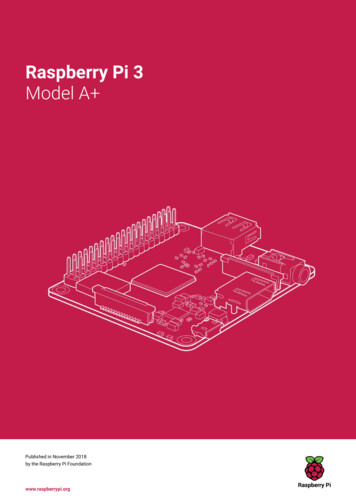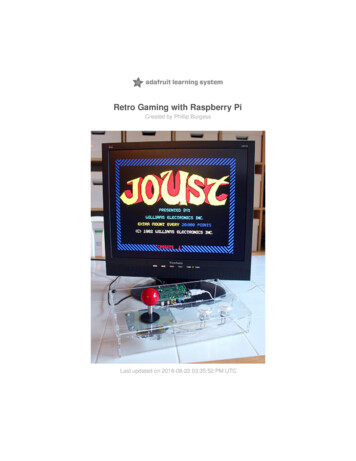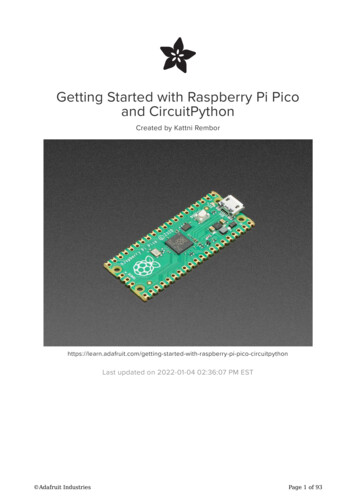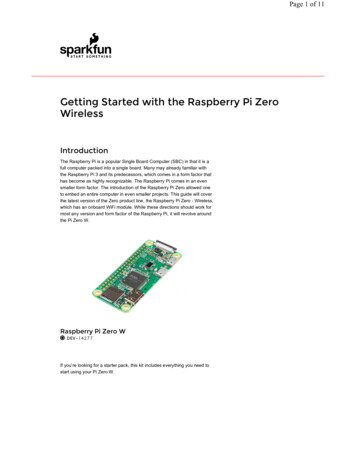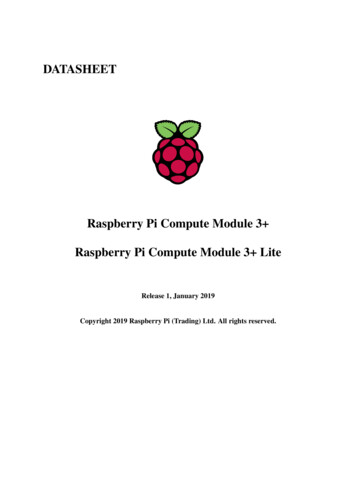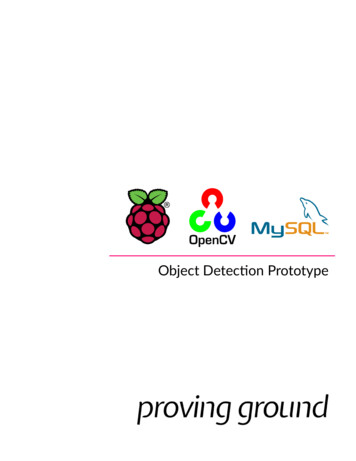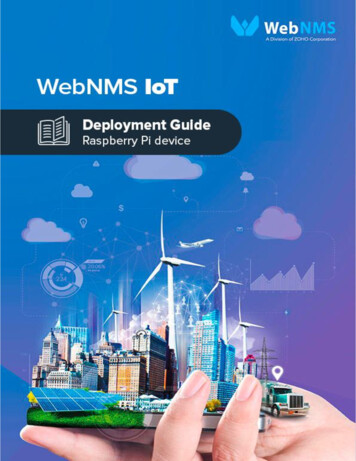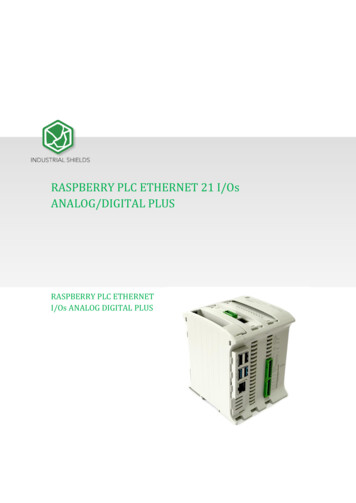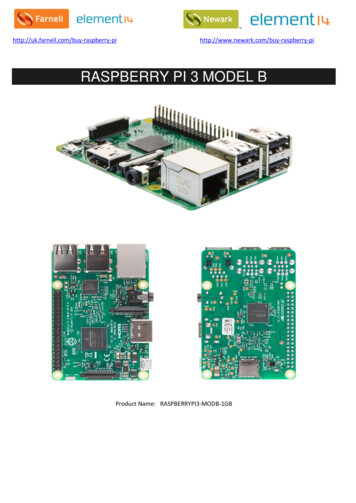
Transcription
ewark.com/buy-raspberry-piRASPBERRY PI 3 MODEL BProduct Name: RASPBERRYPI3-MODB-1GB
ewark.com/buy-raspberry-piTechnical Specification:Processor Broadcom BCM2387 chipset. 1.2GHz Quad-Core ARM Cortex-A53 (64Bit)802.11 b/g/n Wireless LAN and Bluetooth 4.1 (Bluetooth Classic and LE) IEEE 802.11 b / g / n Wi-Fi. Protocol: WEP, WPA WPA2, algorithms AES-CCMP (maximum keylength of 256 bits), the maximum range of 100 meters. IEEE 802.15 Bluetooth, symmetric encryption algorithm Advanced Encryption Standard (AES)with 128-bit key, the maximum range of 50 meters.GPU Dual Core Video Core IV Multimedia Co-Processor. Provides Open GL ES 2.0, hardware-acceleratedOpen VG, and 1080p30 H.264 high-profile decode. Capable of 1Gpixel/s, 1.5Gtexel/s or 24GFLOPs with texture filtering and DMA infrastructureMemory 1GB LPDDR2Operating System Boots from Micro SD card, running a version of the Linux operating system or Windows 10 IoTDimensions 85 x 56 x 17mmPower Micro USB socket 5V1, 2.5AConnectors:Ethernet 10/100 BaseT Ethernet socketVideo Output HDMI (rev 1.3 & 1.4) Composite RCA (PAL and NTSC)Audio Output Audio Output 3.5mm jack HDMI USB 4 x USB 2.0 ConnectorGPIO Connector 40-pin 2.54 mm (100 mil) expansion header: 2x20 strip Providing 27 GPIO pins as well as 3.3 V, 5 V and GND supply linesCamera Connector 15-pin MIPI Camera Serial Interface (CSI-2)Display Connector Display Serial Interface (DSI) 15 way flat flex cable connector with two data lanes and a clock laneMemory Card Slot Push/pull Micro SDIO
ewark.com/buy-raspberry-piThe GPU provides Open GL ES 2.0, hardware-accelerated Open VG, and 1080p30 H.264high-profile decode and is capable of 1Gpixel/s, 1.5Gtexel/s or 24 GFLOPs of general purposecompute. What’s that all mean? It means that if you plug the Raspberry Pi 3 into your HDTV,you could watch BluRay quality video, using H.264 at 40MBits/sThe biggest change that has been enacted with the Raspberry Pi 3 is an upgrade to anext generation main processor and improved connectivity with Bluetooth Low Energy (BLE)and BCM43143 Wi-Fi on board. Additionally, the Raspberry Pi 3 has improved powermanagement, with an upgraded switched power source up to 2.5 Amps, to support morepowerful external USB devices.
ewark.com/buy-raspberry-piThe Raspberry Pi 3’s four built-in USB ports provide enough connectivity for a mouse,keyboard, or anything else that you feel the RPi needs, but if you want to add even more youcan still use a USB hub. Keep in mind, it is recommended that you use a powered hub so as notto overtax the on-board voltage regulator. Powering the Raspberry Pi 3 is easy, just plug anyUSB power supply into the micro-USB port. There’s no power button so the Pi will begin toboot as soon as power is applied, to turn it off simply remove power. The four built-in USBports can even output up to 1.2A enabling you to connect more power hungry USB devices(This does require a 2Amp micro USB Power Supply)On top of all that, the low-level peripherals on the Pi make it great for hardwarehacking. The 0.1" spaced 40-pin GPIO header on the Pi gives you access to 27 GPIO,UART, I2C, SPI as well as 3.3 and 5V sources. Each pin on the GPIO header is identicalto its predecessor the Model B .
SoCBuilt specifically for the new Pi 3, the Broadcom BCM2837 system-on-chip (SoC) includesfour high-performance ARM Cortex-A53 processing cores running at 1.2GHz with 32kBLevel 1 and 512kB Level 2 cache memory, a VideoCore IV graphics processor, and is linkedto a 1GB LPDDR2 memory module on the rear of the board.GPIOThe Raspberry Pi 3 features the same 40-pin general-purpose input-output (GPIO) header asall the Pis going back to the Model B and Model A . Any existing GPIO hardware will workwithout modification; the only change is a switch to which UART is exposed on the GPIO’spins, but that’s handled internally by the operating system.USB chipThe Raspberry Pi 3 shares the same SMSC LAN9514 chip as its predecessor, the Raspberry Pi2, adding 10/100 Ethernet connectivity and four USB channels to the board. As before, theSMSC chip connects to the SoC via a single USB channel, acting as a USB-to-Ethernet adaptorand USB hub.AntennaThere’s no need to connect an external antenna to the Raspberry Pi 3. Its radios areconnected to this chip antenna soldered directly to the board, in order to keep the size ofthe device to a minimum. Despite its diminutive stature, this antenna should be more thancapable of picking up wireless LAN and Bluetooth signals – even through walls.
ewark.com/buy-raspberry-pi
ewark.com/buy-raspberry-piKey Improvements from Pi 2 Model B to Pi 3 Model B: Next Generation QUAD Core Broadcom BCM2837 64bit ARMv7 processorProcessor speed has increased from 900MHz on Pi 2 to 1.25Ghz on the RPi 3 Model BBCM43143 Wi-Fi on boardBluetooth Low Energy (BLE) on boardUpgraded switched power source up to 2.5 Amps (can now power even more powerful devices overUSB ports)The main differences are the quad core 64-bit CPU and on-board Wi-Fi and Bluetooth. The RAM remains 1GBand there is no change to the USB or Ethernet ports. However, the upgraded power management shouldmean the Pi 3 can make use of more power hungry USB devicesFor Raspberry Pi 3, Broadcom have supported us with a new SoC, BCM2837. This retains the same basicarchitecture as its predecessors BCM2835 and BCM2836, so all those projects and tutorials which rely on theprecise details of the Raspberry Pi hardware will continue to work. The 900MHz 32-bit quad-core ARM CortexA7 CPU complex has been replaced by a custom-hardened 1.2GHz 64-bit quad-core ARM Cortex-A53In terms of size it is identical to the B and Pi 2. All the connectors and mounting holes are in the same placeso all existing add-ons, HATs and cases should fit just fine although the power and activity LEDs have moved tomake room for the WiFi antenna.The performance of the Pi 3 is roughly 50-60% faster than the Pi 2 which means it is ten times faster than theoriginal Pi.All of the connectors are in the same place and have the same functionality, and the board can still be runfrom a 5V micro-USB power adapter. This time round, we’re recommending a 2.5A adapter if you want toconnect power-hungry USB devices to the Raspberry Pi.Raspberry Pi 3 Model BRaspberry Pi 2 Model B
rnell.com/buy-raspberry-piRaspberry Pi 3Model BRaspberry Pi 2Model BModel B Model A Model ACMDKProcessor ChipsetBroadcom BCM283764Bit ARMv7 QuadCore Processorpowered SingleBoard Computerrunning at 1250MHzBroadcom BCM283632bit ARMv7 QuadCore Processorpowered SingleBoard Computerrunning at 900MHzBroadcomBCM2835 32bitARMv6 SoC fullHD multimediaapplicationsprocessorBroadcomBCM2835 32bitARMv6 SoC fullHD multimediaapplicationsprocessorBroadcomBCM2835 32bitARMv6 SoC fullHD multimediaapplicationsprocessorBroadcomBCM2835 32bitARMv6 SoC fullHD multimediaapplicationsprocessorGPUVideocore IVVideocore IVVideocore IVVideocore IVVideocore IVVideocore IVProcessor SpeedQUAD Core @1250MHzQUAD Core @900MHzSingle Core @700MHzSingle Core @700MHzSingle Core @700MHzSingle Core@700 MHzRAM1GB SDRAM @ 400MHz1GB SDRAM @ 400MHz512 MB SDRAM@ 400 MHz256 MB SDRAM@ 400 MHz256 MB SDRAM@ 400 MHz512 MB SDRAM@ 400 MHzStorageUSB 2.0Power Draw /voltageMicroSD4x USB Ports2.5A @ 5VMicroSD4x USB Ports1.8A @ 5VMicroSD4x USB Ports1.8A @ 5VMicroSD1x USB Port1.8A @ 5VSDCard1x USB Port1.2A @ 5V4GB eMMC1x USB Port1.8A @ 5VGPIOEthernet PortWi-FiBluetooth LE40 pinYesBuilt inBuilt in40 pinYesNoNo40 pinYesNoNo40 pinNoNoNo26 pinNoNoNo120 pinNoNoNo
For Raspberry Pi 3, Broadcom have supported us with a new SoC, BCM2837. This retains the same basic architecture as its predecessors BCM2835 and BCM2836, so all those projects and tutorials which rely on the precise details of the Raspberry Pi hardware will
